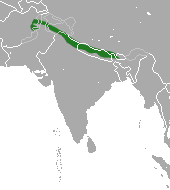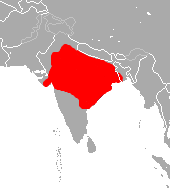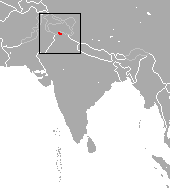Gray langur group- Semnopithecus
Black footed gray langur
 It is found in Southern India, the black footed gray langur. Goa, Karnataka and Kerala are specific areas to look in, but is centred on the Western Ghats. Its total range is around 35,000 km2, with the species living inside and outside of protected areas. There is not a well known estimate of the population size, but given it is least concern it is likely to be relatively easy to find.
It is found in Southern India, the black footed gray langur. Goa, Karnataka and Kerala are specific areas to look in, but is centred on the Western Ghats. Its total range is around 35,000 km2, with the species living inside and outside of protected areas. There is not a well known estimate of the population size, but given it is least concern it is likely to be relatively easy to find.
Conservation status is least concern, however while the population size is unknown it is known to be decreasing.
Nepal gray langur
Endemic  to the Himalayas in Nepal, far southwestern Tibet, northern India, northern Pakistan, Bhutan and possibly Afghanistan. It is found in forests at an elevation of 1,500 to 4,000 metres Its easternmost limit in India is Buxa Tiger Reserve in northern West Bengal, at least up to the Rydak river. The Nepal gray langur is comfortable on the ground and in the trees. At 26.5 kilograms, the heaviest langur was of this species
to the Himalayas in Nepal, far southwestern Tibet, northern India, northern Pakistan, Bhutan and possibly Afghanistan. It is found in forests at an elevation of 1,500 to 4,000 metres Its easternmost limit in India is Buxa Tiger Reserve in northern West Bengal, at least up to the Rydak river. The Nepal gray langur is comfortable on the ground and in the trees. At 26.5 kilograms, the heaviest langur was of this species
Conservation status is least concern however while the population size is unknown it is known to be decreasing.
Nilgiri Langur
Covered in black hair, apart from its head which has brown hair on its head (females has a white patch of fur on their thighs). Generally living in troops of 9-10 they are found in the Nilgiri Hills of the Western Ghats in South India.
black hair, apart from its head which has brown hair on its head (females has a white patch of fur on their thighs). Generally living in troops of 9-10 they are found in the Nilgiri Hills of the Western Ghats in South India.
Its range also includes Kodagu in Karnataka, Kodayar Hills in Tamil Nadu, and many other hilly areas in Kerala and Tamil Nadu. It is also found in Silent Valley National Park of Kerala.
Current conservation status is considered vulnerable with a population of 9500-10000
Northern plains gray langur
Also known as sacred langur, Bengal sacred langur and Hanuman langur. Often associating with chital deer, the two species are better at spotting different predators. They have also been seen grooming with Rhesus monkeys though in Delhi they are used to drive of this species
sacred langur, Bengal sacred langur and Hanuman langur. Often associating with chital deer, the two species are better at spotting different predators. They have also been seen grooming with Rhesus monkeys though in Delhi they are used to drive of this species
Conservation status is least concern again with a decreasing population, though i cannot find the exact population size
Purple-faced Langur
 The purple faced langur is a species found in Sri Lanka. There are 3 recognized subspecies,
The purple faced langur is a species found in Sri Lanka. There are 3 recognized subspecies,
Conservation status is endangered with a decreasing population size.
Taral gray langur
 Found in the Himalayas this species of langur is currently listed as near threatened, though with a decreasing population it may well get worse with time. It is currently thought to have a population of around 10,000
Found in the Himalayas this species of langur is currently listed as near threatened, though with a decreasing population it may well get worse with time. It is currently thought to have a population of around 10,000
Tufted gray langur
It is unlikely to  come as a surprise, that being found on the mainland and on Sri Lanka, there are 2 recognized subspecies.
come as a surprise, that being found on the mainland and on Sri Lanka, there are 2 recognized subspecies.
Conservation status is near threatened, with an unknown population size (though it is known to be decreasing).
Kashmir gray langur
The Kashmir gray Langur is only known from a small area it only occurs in the Chamba Valley in Himachal Pradesh, though there are reports of areas of northwestern India. It was initially considered a subspecies of the northern plains langur above.
gray Langur is only known from a small area it only occurs in the Chamba Valley in Himachal Pradesh, though there are reports of areas of northwestern India. It was initially considered a subspecies of the northern plains langur above.
Conservation status is endangered with just 250 adults and it is considered endangered (other sources put the population at a more healthy 1400-1500 though still with a decreasing direction)